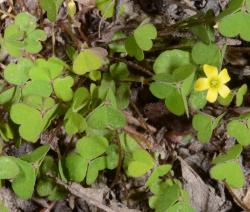- Taxon
- Gallery
- = Oxalis ciliifera A.Cunn. (1839)
- = Oxalis tenuicaulis A.Cunn., Ann. Nat. Hist. 3: 316 (1839)
- = Oxalis corniculata var. microphylla Hook.f., Bot. Antarct. Voy. II. (Fl. Nov.-Zel.) Part I, 42 (1852)
Perennial; primary root slender to stout, occasionally to c. 10 mm thick. Stems glabrous to densely hairy (hairs usually antrorse, occasionally dense and patent), ± filiform, creeping, prostrate or nearly so, rooting at nodes, much-branched and often mat-forming. Lvs 3-foliolate. Petiole 5–40 mm long, with patent or antrorse hairs, these sparse to dense; stipules adnate, truncate or rounded at apex. Petiolules very short. Lamina of leaflets equal, 1–9 × 1.5–12 mm, obcordate, sometimes broadly so, with width > length, with narrow to broad sinus and rounded lobes, glabrous or hairy above, glabrate or with appressed hairs beneath, ciliate or eciliate, often purplish below; calli 0. Fls solitary, rarely paired; peduncle glabrate to densely clothed in antrorse hairs, generally geniculate at apex; pedicel (4)–8–25 mm long. Bracts 1–3 mm long, ± linear-subulate, hairy, situated at base or at middle of pedicels; calli 0. Sepals 2.3–3.5–(4) mm long, oblong-lanceolate, oblong, or ovate-elliptic, glabrate or with antrorse hairs; calli 0. Petals 4.5–9–(13) mm long, ± oblong-obovate, yellow, often pink-flushed outside, glabrous. Stamens at 2 levels, glabrous or nearly so; filaments united at base, those of longer whorl c. 1.5 mm long. Styles < or > longer stamens, densely hairy. Capsule (3)–7–10–(13) mm long excluding styles, broadly cylindric, cylindric-ovoid or conic, glabrous to densely hairy; hairs short, patent or retrorse, sometimes glandular. Seed 1–1.3–(1.5) mm long, broad-ellipsoid; transverse ridges 7–13, subacute, sometimes white-topped; grooves deep.
[From: Webb et al. (1988) Flora of New Zealand. Volume 4.]
Flowering: Jan.–Dec.




